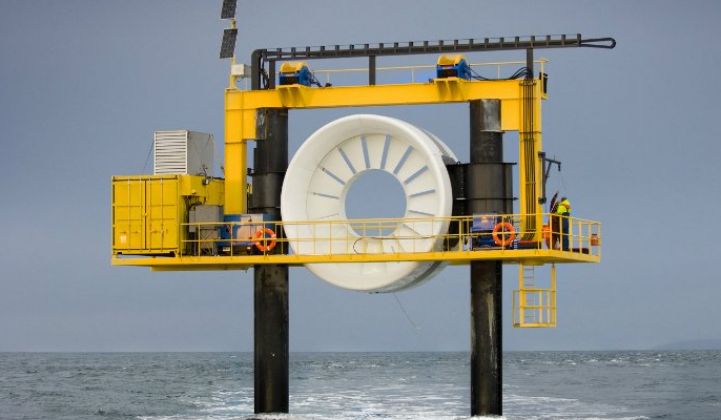A U.K. plan to marry hydrogen storage with tidal power looks too costly to make commercial sense. But it is not really supposed to, according to promoters at the European Marine Energy Center (EMEC) tidal and wave test site in Orkney, Scotland.
“EMEC is the world-leading test center for wave and tidal machines and there is a huge amount of learning to be undertaken on these innovative technologies,” said Neil Kermode, EMEC’s managing director. “The real value is in the learning about the technology, not just the electricity they produce at this prototype stage. So this is not just an energy storage project.”
Last month, EMEC announced that it would be investing £1.79 million ($2.77 million) in a half-megawatt polymer electrolyte membrane electrolyzer with capacity for up to 500 kilos of hydrogen storage. The system is due to be installed by March 2016 on the island of Eday in Orkney.
“The electrolyzer will be used to absorb excess power generated by the tidal turbines testing at EMEC,” said hydrogen system vendor ITM Power in a press release.
“The hydrogen gas generated will be compressed and stored, with some of the gas being used in a hydrogen fuel cell to provide backup power to critical EMEC systems.”
The system will feature extensive data gathering systems, including telemetry, cameras and radar, at EMEC’s tidal test center at the Fall of Warness.
Excess hydrogen from the storage system will be used offsite in a separate project to absorb surplus output from a community wind turbine operated by local developer Eday Renewable Energy, ITM Power said.
Some form of storage was needed at EMEC because of its location far from major power markets, Kermode told GTM. “This project is complicated by the local grid arrangements in Orkney,” he noted.
“Already Orkney produces more electricity from renewable sources, mainly wind, than it uses, so grid space is precious. The grid was never designed to have generation on these remote islands and so there are inadequacies and pinch points, which mean generation is frequently curtailed in order to protect the fragile parts of the network," said Kermode.
Nevertheless, the decision to tie tidal power to a power-to-gas storage medium such as hydrogen is an unusual one from a purely commercial perspective.
“Power-to-gas remains limited to pilot projects for the most part, and this project appears to be no different," said Bloomberg New Energy Finance associate Logan Goldie-Scot.
“Aside from the economic challenges of power-to-gas, the levelized cost of electricity for tidal remains considerably higher than other generation technologies, with a central scenario for the first half of 2015 of roughly $440 per megawatt-hour," he said.
However, Kermode confirmed that the main aim of the EMEC project is not to produce and store energy cost-effectively now, but to lay the groundwork for cost-effective marine renewable generation in the future.
“Practically all areas where there are strong marine resources are served by weak grids,” said Kermode, "so getting energy away from these areas is going to be a challenge. Electricity is one way of transporting energy, but it is not the only one.”
Kermode said EMEC had looked at more traditional energy storage technologies, such as batteries, but had dismissed them because “they offer a much narrower suite of opportunities in our case.”
“The value of hydrogen is not always best realized as grid electricity. It can be used in place of uninterruptible or remote power supplies, transport fuels or as a chemical feedstock -- and used without carbon emissions," he said. Making hydrogen from electricity and turning it back into electricity will not be the main focus.
Even Philip Hiersemenzel, spokesperson for the German battery storage system developer Younicos, concedes that the EMEC deployment makes sense in the context of research into distant future energy possibilities.
“Hydrogen is not competitive in the grid at the moment, and even with a one-hour duration battery, you can go up to 60 percent to 65 percent renewable energy integration,” he said. “But for the last 20 percent to 25 percent, you will definitely need some kind of long-term electrochemical storage.”
Against this backdrop, Kermode does not rule out installing other storage systems. “EMEC has already tested one form of wave energy storage system from Nottingham University and plans to test other systems as they present themselves,” he said.



